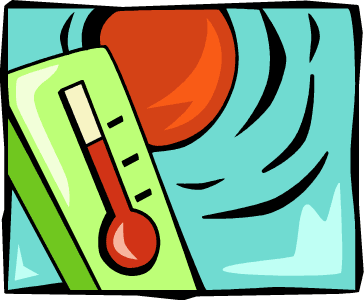
TEMPERATURE, WATER and WEATHER
OBJECTIVES:

Students record data on temperature, clouds, wind and rain once a week. A scientist that studies the weather is called a meteorologist.
Students are learning how to collect data and record it. Putting data on a line graph helps them to visualize the changes through time. Students learn how to read a thermometer.
Students by the end of the school year should learn that temperature changes for several reasons. Time of year because of the quality of the Sun rays, moisture in the air (if rainy) and cloud cover.
| Date | Long-Term Project Schedule |
| Sept | Learn to use a thermometer and observe weather conditions. Start recording regular weather observations at the same time of day. Present introduction lesson. |
| Oct | Record weather observations at the same time of day. Plot information on graph Docent Lesson |
| Nov | Record weekly temperature and weather observations at the same time of day. Start graphing the data collected so students can see the transition from fall to winter. Docent Lesson |
| Dec | Record weekly temperature and weather observations at the same time of day and day of week. Docent Lesson |
| Jan | Record weekly temperature and weather observations at the same time of day. Docent Lesson |
| Feb | Record weekly temperature and weather observations at the same time of day. Docent Lesson |
| Mar | Learning the elements of weather and water cycle |
OBJECTIVES:
- Collect temperature and weather observation on a weekly basis.
- Introduce the water cycle and its importance to the entire globe.
- Compare different types of weather that occur throughout the world.
- Learn the importance of temperature to explain weather.
- Introduction to graphs to show how collecting temperature data can show change.
VOCABULARY:
- meteorologist
- data
- weather
- temperature
- clouds
- wind
- thermometer